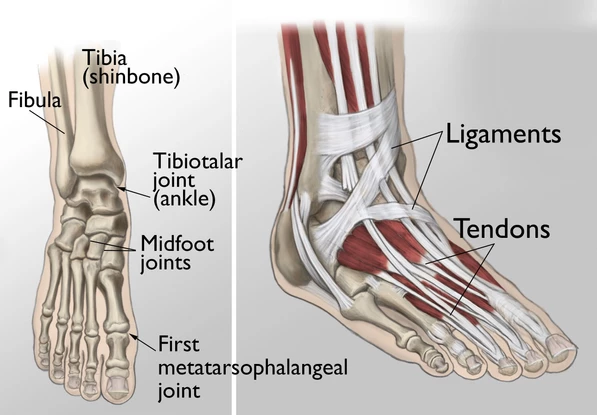Knee pain is a relatively common complaint we see in the office, especially within the running community. Some may come in with clicking, some have used Google to self-diagnose themselves with IT Band syndrome because it is so common in the running population, some won’t even notice the knee pain until they’re 15 miles into a marathon. But all with knee pain, runners or not, we should take a step back and consider a few things.
The knee is at the mercy of the hip and foot/ankle. What does this mean? It’s located right in the middle of the leg and similar to the spine, when the things on either end aren’t working properly, the knee picks up the slack. The knee is also the attachment point for most of the muscles in the thigh as well as the origin for most of the muscles of the calf. All of the muscles intertwine to create the stable foundation which is the knee.
It takes a very comprehensive and functional evaluation to find the true cause of symptoms. And most of the time we see a combination of muscle imbalances, both in the leg and the lower back as well as joint fixation- sometimes in the foot or ankle and sometimes in the hip or pelvis.
Consider this common example: there is a fixation in the tibiotalar joint. Meaning: there is lack of motion where the tibia or shin comes down and attaches to the talus or ankle bone. Most of the time the talus will shift forward, ever so slightly and stick there. When this occurs, the ankle is unable to fully flex and the shock absorption mechanism of the ankle is diminished. Down the chain of events, this will cause an increase forward glide of the knee which causes even more stress to the front of the knee; compensation for the lack of motion in the ankle. Over time, trigger points will form in the calf and the outside of the lower leg. Once this occurs, it is more likely for a simple fixation in the ankle to travel further up the chain and cause symptoms into the lateral part of the thigh or even into the hip. Even if there is never any pain in the knee! A mid-foot striker may never notice they have a difference in this area of the foot/ankle right to left, until they are put through a deep squat screen and notice they struggle to maintain one heel on the ground. IT Band syndrome, or an overly tight lateral thigh can be caused by a number of things. The large ligament located in the side of the leg gets blamed a lot and is the catch-all diagnosis for runners.
What you may not know is that there is actually a muscle embedded in the top of that ligament that lays over top of the glutes. The most lateral portion of your quad has insertions into this band as well as the lateral portion of the hamstring, from the front and back of your thigh respectively. As the IT band attaches into the knee, it crosses over the joint and inserts where the hamstring and the quads do as well as where the lateral calf muscles originate from. The purpose of this very intertwined group of ligaments crossing over each side of the joint is to create stability. When there is tightness in any of the aforementioned muscles, there is increased stress on the IT Band. If the hip joint is overly tight in the posterior aspect (common among almost all athletes) the same is true. The pelvis, which is where this large ligament originates, plays a role as well. When there is lack of motion here, it will pull on the IT band from the top, creating symptoms all the way down the course of the ligament.
Recent research also shows that using a foam roller or lacrosse ball to loosen this muscle is fine and dandy before a run, but a dynamic stretch or even getting on an exercise bike actually accomplishes this much more efficiently. Why? Because you are warming up all of the muscles surrounding the ligament, which is much more effective than simply focusing on the IT Band itself. Get to squatting, lunging and inch worming after you get blood flow into your hips on your roller!
Proper glute activation in runners plays a big role as well. The largest muscles in your body for a reason; the muscles of the buttocks will create stability into the knee as well as the ankle when activated properly. When there is a break the in chain down the leg, the proprioceptive feedback is lost which is needed for proper balance and coordination. This is seen most easily on a one-legged balance or squat test. After having the ankle and hip adjusted, the results are 2-fold. Balance is restored and much of that is due to the increased signal to the brain allowing the glutes and other muscles to work together more properly. There is also proper shared motion through the leg and ankle, allowing for a smoother and easier movement which is lacking when there is fixation.
As muscle imbalances begin to decrease, simple exercises are able to be given to further help increase all of this stability and get rid of some of the unnecessary tone. If you are a runner, you will notice yourself feeling much more stable through each stride as all the muscles work together properly and joints move as they are supposed to.
If you want to take things to the next level or have questions about any of these concepts, feel free to stop in for a free consultation with me, Dr. Kylie. I would love to be able to help you meet and exceed your goals and keep you running better, longer!
-Kylie Rabe, DC
Rogan Sports Clinic



